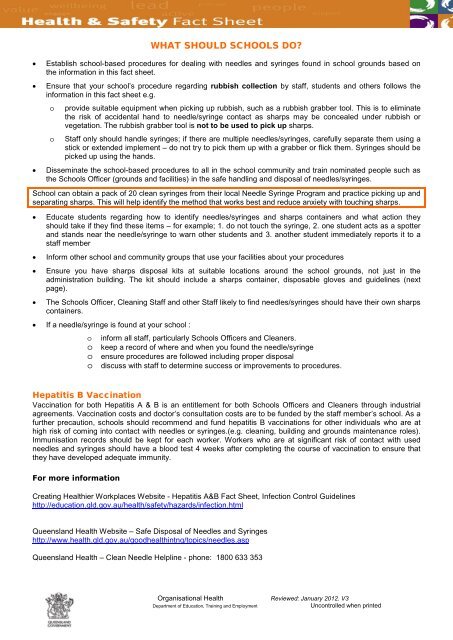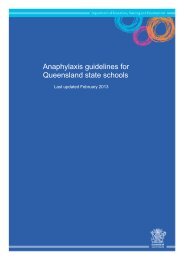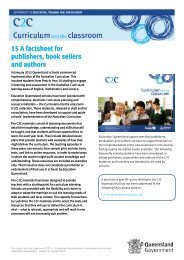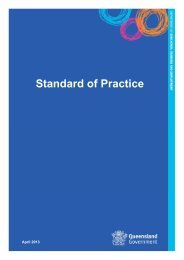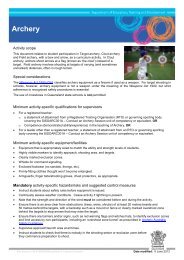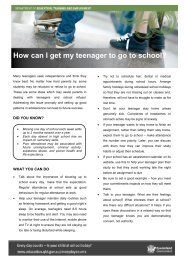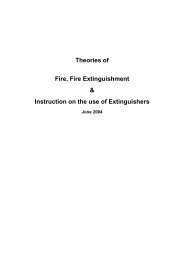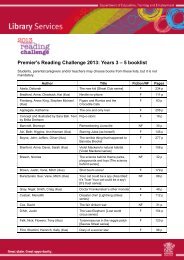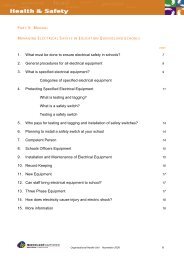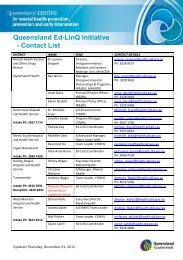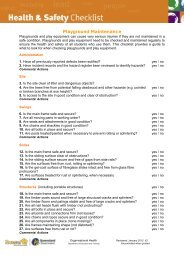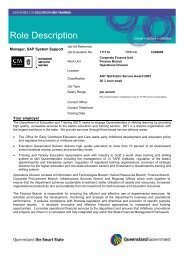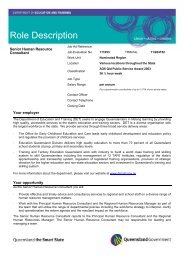Safe Handling and Disposal of Needles and Syringes - Education ...
Safe Handling and Disposal of Needles and Syringes - Education ...
Safe Handling and Disposal of Needles and Syringes - Education ...
Create successful ePaper yourself
Turn your PDF publications into a flip-book with our unique Google optimized e-Paper software.
WHAT SHOULD SCHOOLS DO?<br />
• Establish school-based procedures for dealing with needles <strong>and</strong> syringes found in school grounds based on<br />
the information in this fact sheet.<br />
• Ensure that your school’s procedure regarding rubbish collection by staff, students <strong>and</strong> others follows the<br />
information in this fact sheet e.g.<br />
o provide suitable equipment when picking up rubbish, such as a rubbish grabber tool. This is to eliminate<br />
the risk <strong>of</strong> accidental h<strong>and</strong> to needle/syringe contact as sharps may be concealed under rubbish or<br />
vegetation. The rubbish grabber tool is not to be used to pick up sharps.<br />
o Staff only should h<strong>and</strong>le syringes; if there are multiple needles/syringes, carefully separate them using a<br />
stick or extended implement – do not try to pick them up with a grabber or flick them. <strong>Syringes</strong> should be<br />
picked up using the h<strong>and</strong>s.<br />
• Disseminate the school-based procedures to all in the school community <strong>and</strong> train nominated people such as<br />
the Schools Officer (grounds <strong>and</strong> facilities) in the safe h<strong>and</strong>ling <strong>and</strong> disposal <strong>of</strong> needles/syringes.<br />
School can obtain a pack <strong>of</strong> 20 clean syringes from their local Needle Syringe Program <strong>and</strong> practice picking up <strong>and</strong><br />
separating sharps. This will help identify the method that works best <strong>and</strong> reduce anxiety with touching sharps.<br />
• Educate students regarding how to identify needles/syringes <strong>and</strong> sharps containers <strong>and</strong> what action they<br />
should take if they find these items – for example; 1. do not touch the syringe, 2. one student acts as a spotter<br />
<strong>and</strong> st<strong>and</strong>s near the needle/syringe to warn other students <strong>and</strong> 3. another student immediately reports it to a<br />
staff member<br />
• Inform other school <strong>and</strong> community groups that use your facilities about your procedures<br />
• Ensure you have sharps disposal kits at suitable locations around the school grounds, not just in the<br />
administration building. The kit should include a sharps container, disposable gloves <strong>and</strong> guidelines (next<br />
page).<br />
• The Schools Officer, Cleaning Staff <strong>and</strong> other Staff likely to find needles/syringes should have their own sharps<br />
containers.<br />
• If a needle/syringe is found at your school :<br />
o inform all staff, particularly Schools Officers <strong>and</strong> Cleaners.<br />
o keep a record <strong>of</strong> where <strong>and</strong> when you found the needle/syringe<br />
o ensure procedures are followed including proper disposal<br />
o discuss with staff to determine success or improvements to procedures.<br />
Hepatitis B Vaccination<br />
Vaccination for both Hepatitis A & B is an entitlement for both Schools Officers <strong>and</strong> Cleaners through industrial<br />
agreements. Vaccination costs <strong>and</strong> doctor’s consultation costs are to be funded by the staff member’s school. As a<br />
further precaution, schools should recommend <strong>and</strong> fund hepatitis B vaccinations for other individuals who are at<br />
high risk <strong>of</strong> coming into contact with needles or syringes.(e.g. cleaning, building <strong>and</strong> grounds maintenance roles).<br />
Immunisation records should be kept for each worker. Workers who are at significant risk <strong>of</strong> contact with used<br />
needles <strong>and</strong> syringes should have a blood test 4 weeks after completing the course <strong>of</strong> vaccination to ensure that<br />
they have developed adequate immunity.<br />
For more information<br />
Creating Healthier Workplaces Website - Hepatitis A&B Fact Sheet, Infection Control Guidelines<br />
http://education.qld.gov.au/health/safety/hazards/infection.html<br />
Queensl<strong>and</strong> Health Website – <strong>Safe</strong> <strong>Disposal</strong> <strong>of</strong> <strong>Needles</strong> <strong>and</strong> <strong>Syringes</strong><br />
http://www.health.qld.gov.au/goodhealthintnq/topics/needles.asp<br />
Queensl<strong>and</strong> Health – Clean Needle Helpline - phone: 1800 633 353<br />
Organisational Health Reviewed: January 2012. V3<br />
Department <strong>of</strong> <strong>Education</strong>, Training <strong>and</strong> Employment Uncontrolled when printed


